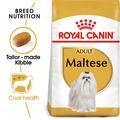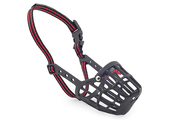
The exact origin of the breed is unknown, although it has been suggested that the Maltese developed on the island of Malta over 2,000 years ago, being brought to England by Crusaders on their return from the Mediterranean. Other theories describe how the Maltese must have made its way from the Middle East through Europe, accompanying the migrating nomadic tribes. It is likely that the breed evolved from Spitz-type dogs as it bears a slight resemblance to the family, with a profuse coat and small features. Appearing in ancient pictorials, the Maltese is shown to have served as a therapy and healer dog, helping to cure the sick and infirm. Due to its portable size and amiable temperament, the Maltese was commonly traded for goods, whilst being a popular breed choice of royalty. Registered by the American Kennel Club in 1886.
Reflecting on its appearance, structure and size, it is hardly surprising that many attribute its development to the Miniature Spaniel and the Poodle. Boasting a small, proportioned frame, the Maltese has dark eyes, a moderate length muzzle, hanging pendant ears and a black nose. The coat is typically long, straight and heavily feathered, and is commonly coloured ivory or white. Regular grooming is necessary with this breed in order to promote coat appearance, condition and manageability. Primarily bred as a faithful companion dog, the Maltese is popular in the celebrity world, being highly prized for its elegant appearance and trainable temperament.
A lively and boisterous breed, the Maltese benefits from consistent obedience training, firm leadership and early socialisation in order to discourage destructive behaviours around the home. Highly intelligent, curious, engaged and energetic, the Maltese makes a great playmate for children, providing they recognise its need for space and respect. Devoted to its master and family and naturally vigilant, the Maltese can be relied upon to alert you to change or threat. In general, a fully grown Maltese will weigh 3-4 kg, with a life expectancy of 15 years, although it is very common for the breed to outlive this expectancy, with documented cases of Maltese dogs living into their 20s.
The Maltese is susceptible to various health conditions, ranging from minor to more serious. As with most breeds, optical disorders, skin allergies, and orthopedic complaints are prevalent in the Maltese, as are cases of liver disease, cancer, and epilepsy. Due to its small size, breathing difficulties are commonly observed in the breed, as are behavioural problems arising from 'Small Dog Syndrome.'








From United Kingdom
Maltese are real characters .... and real companion dogs! Quite strong willed, they love people & other digs & are very loyal. I wouldn’t be without my two!